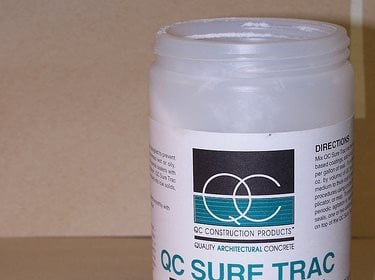How to Fix Slippery Concrete
Expert tips on making pool decks, patios, and walkways less slipperyIf your concrete is slippery, applying a sealer with a girt additive can add traction. Read the following expert Q&As to learn more about how to fix slippery concrete.
ALUMINUM OXIDE BEADS vs. POLYMER GRIT
Question:
I have a customer who has a stamped concrete pool deck, but is having problems with slip resistance. The concrete is sealed with an acrylic sealer. Are #80 aluminum oxide beads for improving slip resistance compatible with acrylic sealer?
Hire a contractor near me to fix my slippery concrete
Answer:
There should be no chemical incompatibility between aluminum oxide and an acrylic sealer. But you may encounter other problems using #80 aluminum oxide beads. Aluminum oxide is heavy and when incorporated into an acrylic sealer it will tend to sink to the bottom, doing little to increase slip resistance at the surface. The other factor is the dark, opaque color of aluminum oxide, which could detract from the color and aesthetics of the stamped concrete.
A better method for increasing slip resistance is to use polymer grit additives. These fine, rough-shaped pieces of plastic are light enough to remain suspended in the sealer and they are translucent (clear). Some manufacturers provide polymer grit in different sizes for different levels of slip resistance. I encourage you to prepare a sample for the homeowner to evaluate before sealing the entire pool deck.
Another good option for fixing slippery concrete around a pool is to apply a spray texture coating.
INCREASING SLIP RESISTANCE OF SEALED CONCRETE
Question:
I have a colored and sealed walkway that is at a slight incline. I love the color, but every time it rains or gets wet the walkway becomes very slippery. Is there anything I can do to make it less slippery without affecting the color?
Answer:
Sealers for decorative concrete provide protection and enhance color. But the same thin, plastic layer that provides this protection and color enhancement also becomes very slippery when wet.
When dry, most sealers pass the national standards set by OSHA (Occupational Safety and Health Administration) for slip resistance. When wet, however, most fail these standards or are borderline. The texture of the concrete also plays a big part, which is why most walkways, pool decks, and driveways are broom finished or textured.
In the case of the walkway that is at a slight incline, the surface is not doing much to create slip resistance, and the sealer is making it worse. There are two ways to solve this problem. The first is to strip off the sealer and leave the concrete surface bare. While this solves the problem, it defeats the purpose and you no longer have the benefits of sealer protection and color enhancement.
The second, and more viable, solution is to combine a grit additive with the final coat of sealer to increase the grip of the sealer. Many years ago, silica sand was used to create grit in clear sealers. The sand did solve the slip issue, but it made the sealer cloudy. Some years ago, a clear plastic (polyethylene) grit additive was introduced. It is made from the same plastic used to make 2-liter soda bottles, ground into a fine powder. If you look at the powder under a microscope, the particles look rough and jagged like sand but are clear. When added to a clear sealer, they disappear to the naked eye. When the sealer dries, they create a rough surface underfoot, especially when wet. You can buy clear plastic grit in different sizes, depending on the level of traffic exposure and how much surface traction is needed. In the case of the slippery walkway, simply re-applying a thin coat of sealer with polymer grit additive should do the trick. Be aware that you can't spray apply sealers containing grit, and over time the sealer will wear and require maintenance.





